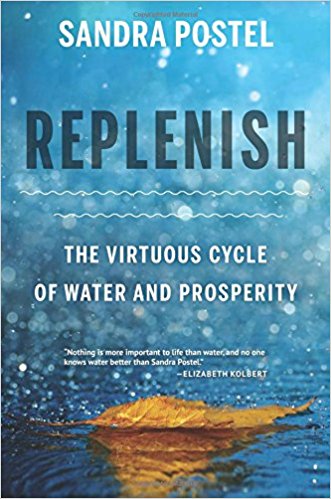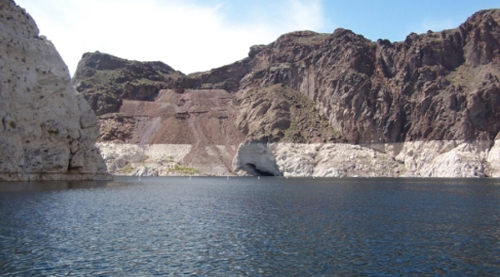How You Can Help Fix the Global Water Crisis
January 17, 2018
An interview with Sandra Postel by Elaina Zachos, National Geographic
The average American directly uses about 2,000 gallons of water each day. Your morning shower takes 17 gallons of water and growing the coffee beans for your cup of joe took upwards of 34 gallons. It takes 13 gallons of water to generate one gallon of gas, which adds up on your commute to work or school. The desktop computer you’ll sit at for a good portion of the day took about 7,300 gallons of water to make.
Before lunch, you’ve used up thousands of gallons of water. (Use this calculator to figure out your water footprint.)
Sandra Postel, director of the Global Water Policy Project and former National Geographic Society Freshwater Fellow, demystifies humanity’s obsession with water in her new book Replenish. When National Geographic caught up with her in New Mexico, she explained how people are coming up with innovative ways to conserve water before we run dry.
 The book begins in a Colorado canyon. Can you describe the scene?
The book begins in a Colorado canyon. Can you describe the scene?
The opening of the book describes a trip up through a canyon known as the Cache la Poudre. There had been a fire in this canyon the previous year, so you could see the blackened trees. I was heading to a family wedding, an outdoor wedding, and it looked like it was going to just start to pour at any minute. I was contemplating the sky. The wedding happened OK, but this was the beginning of a deluge that produced an enormous amount of flooding. Because the trees had been burned so recently, there was just a lot of erosion and a lot of tree trunks moving down through that canyon.
I opened the book with this story because I was there to see the canyon right before this happened but also to indicate that the combination of wildfires and flooding and drought is coming together. We’re moving into a very different period where the past is not going to be a very good guide for the future.
Why did you write this book?
There are so many ways in which the global water cycle is broken. And water security, down the line, is going to increasingly mean finding ways to fix this water cycle. This is the greatest asset on the planet and we need to come up with new solutions. We’re running out of places to build dams cost effectively and in a way that’s not going to cause harm. We’re running out of the ability to pump more ground water because we’re already depleting so much.
My goal with the book was to find those innovative farmers, ranchers, cities, communities that are showing we can have a healthier water cycle. We can repair it, we can replenish it, we can rebuild it.
You take the reader across the U.S. and also to China. What was your favorite place to research for this book?
The Verde River in Arizona is a gem of a river in the Southwest. In the desert Southwest, rivers are lifelines for birds and wildlife and irrigators and communities. They’re extremely important in so many ways.
But irrigators are taking water out of this river in the way that they’ve been doing for a century and a half. And so, the river was dry for five, six, seven, eight miles at a time. Obviously this isn’t good for birds, for fish, and for the community.
A very entrepreneurial hydrologist with The Nature Conservancy worked with these irrigators in the Verde Valley to find a way to use that water in a smarter fashion. And the solution in this case was putting in a solar-powered head gate on the ditch system that allowed the irrigators to take just the water they needed and leave the rest for the river.
There had to be partnership between, in this case, a conservation organization and irrigators in the valley, a willingness to try this, and a technology that was going to allow this smarter water use to happen. Water’s finite, so it’s all about getting smarter about how we use it and increasing the value of it.
In the book, you mention how much water it takes to make a pizza.
We tend to think of water only as it’s coming out of our tap in the morning when we’re brushing our teeth or washing vegetables or whatever. But, in fact, water is imbedded in everything we use and buy and do throughout the day.
And I give the example of a margarita pizza. It takes about 330 gallons of water to make a delicious pizza, most of that going into growing the feed to raise the cattle that we milk for the cheese and to growing the tomatoes. These are very water-intensive activities, especially agriculture.
What are some ways that people can reduce their use of water?
Conservation and more conscious consumption. Not just turning off the tap, as important as that is, but thinking about how much food we waste. Every time we throw away a cup of coffee that we don’t drink, we’re indirectly throwing away 34 gallons of water because it takes a lot of water to grow those coffee beans.
Buying recycled things helps a lot because you’re then using recycled materials rather than using water to make things brand new. If you buy a shirt from a second-hand store, well, you’re not causing 700 more gallons to be used to make a new shirt. How many t-shirts do we need, you know? [Laughs]
I don’t want to sound preachy about it, but as we get aware of the amount of water it takes to make everything, we realize if we just think about it there are so many ways we can shrink that footprint: using more recycled materials, turning off lights when we’re not in the room, being careful about trying to walk and bike more than use our cars, combine our errands so we reduce the amount of driving we do. It’s that consciousness that allows us to really realize there are ways we can shrink our personal footprint.

The white “bathtub ring” around Lake Mead, the largest reservoir on the Colorado River, demarcates the lake’s previous higher levels. Photo: Sandra Postel
In the book, you quote a professor named James E. McWilliams saying, “there’s no such thing as a beef-eating environmentalist.” Could you elaborate on that a little bit?
We blame cattle for a lot of things, and really, it’s how we manage cattle—not the cattle themselves—that determine their impacts. There’s been a lot written suggesting it takes on the order of 630 gallons of water to make one hamburger. Well, what if the cattle were raised in a different way? If you’re raising cattle to produce beef on the natural range, this is a natural ecosystem that is already there. And if you can sustainably add cattle to that grassland, you can often improve the ecosystem. This practice of managed grazing rotates cows regularly from one paddock to another and mimics the ways bison used to move naturally on the range.
You can actually store more carbon on the soil, improve the amount of water that’s stored in the soil, and improve the health of those grassland habitats over all. The water footprint of a burger that comes from a cow raised that way is very different from the water footprint of a cow raised, say, with irrigated corn and then sent to a feed lot.
Now, I would hasten to add that I doubt very much that we could produce enough beef in this sustainable fashion to meet the current demand for beef. I don’t think that we could meet the current demand for beef in these ways and so it does require, again, some choices on the consumer’s side to reduce that beef consumption and to choose more sustainably raised meat.
What are some immediate effects we would see if we were to start doing these more sustainable farming practices, or just be more conscious?
Industrial agriculture erodes soil. It diminishes the health of the soil, adds chemicals to the soil, and so you’re sort of losing the capacity of that soil reservoir to store water and create resilience against drought in that way. If you add up the amount of water that can be stored in soils around the world, you find that it’s eight times the amount that all rivers combined hold at any one given time. It’s a big potential reservoir. And we can expand it if we choose to manage the land, particularly farmland and ranch land, in ways that expand that reservoir.
I quote someone in the book saying that it’s not how much rain you get in the rain gauge, it’s how much rain you actually absorb and keep on the land that determines how much real water you have to grow your crops, to grow the grass for the cattle. So, it’s thinking of the soil not just as where the roots of the plant are but as an active reservoir of water, an act of managing the soil to expand and improve that soil reservoir.
In the book, you present a lot of examples about how we can be more optimistic with our water usage, but there’s also some not-so-optimistic examples. How do you remain optimistic about water?
The challenges are big, no question about it. These are very serious issues and they’re not going to be easy to solve. But what allows me to be optimistic is being able to point to solutions in each of these critical areas. There are examples in each of these areas of how we can repair and replenish the water cycle. It can be done.
This interview was edited for length and clarity.
Originally published at National Geographic
